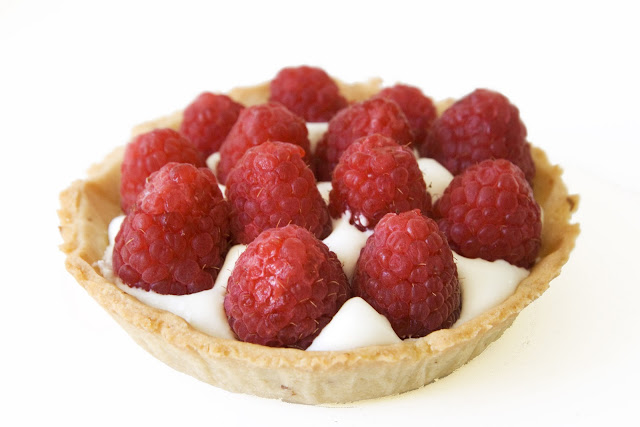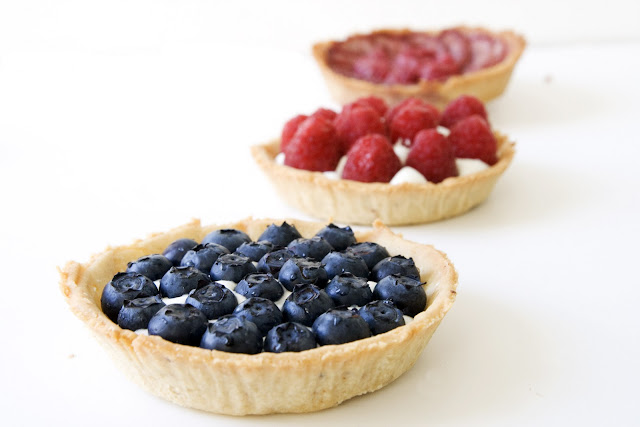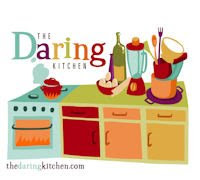Crostata.
This month’s Daring Bakers’ Challenge was Crostata hosted by Simona from briciole.
What is a crostata?
It’s a Italian baked dessert tart. Traditionally prepared by folding up the edges of the dough over the top of the filling, creating a “rough” look. The crostata can also be filled with fresh fruit and pastry cream.
The base of a crostata is pasta frolla (or pastafrolla), sweet short crust pastry (or sweet tart dough) made of flour, sugar, butter and eggs. Pasta frolla is versatile: it provides the base to make crostata with fruit preserves, pastry cream, fresh fruit, ricotta, and other ingredients, and, by itself, it makes very nice cookies.
Pasta frolla
Ingredients
1/3 cup granulated sugar
1 1/4 cup unbleached all-purpose flour
1/4 cup almond flour
a pinch of salt
6 tbsp cold unsalted butter, cut into small pieces
1 large egg, lightly beaten
1/4 teaspoon vanilla extract
- Whisk together sugar, salt, all-purpose flour and almond flour in a bowl.
- Rub the butter pieces into the sugar and flour mixture until it has the consistency of coarse crumbs. (I found it easier to do it inside the bowl to prevent a mess)
- Make a well in the center of the flour and butter mixture and pour the beaten egg and vanilla extract into it. (You can do this on your kitchen counter or in the bowl)
- Use a fork to incorporate the liquid into mixture and then use your fingertips.
- Knead lightly just until the dough comes together into a ball.
- Shape the dough into a flat disk and wrap in plastic wrap. Place the dough in the refrigerator and chill for at least two hours. You can refrigerate the dough overnight.
Crema pasticcera
Source
Ingredients
2 extra-large eggs
1/3 cup granulated sugar
500 ml milk (slightly more than 2 cups)
3 strips of lemon peel (~3″ long and 1/2″ wide)
3 tablespoons pastry (or unbleached regular) flour
- Pour the milk into a pan, add the lemon peel and warm up to to well below boiling point.
- In a mixing bowl, beat the eggs with the sugar until the mixture is bubbly.
- Sift the flour over the egg mixture and beat briefly until it is incorporated.
- Temper the egg mixture with a small quantity of milk, then slowly add the rest of the milk, mixing with a wooden spoon. Pour the mixture into the pan and set it to very low heat, stirring at least every couple of minutes.
- When the froth on the surface disappears completely, the crema starts to feel slightly thicker. From then on stir almost continuously.
- When the crema reaches boiling temperature and thickens, cook briefly (1-2 minutes), then remove the pan from the heat, remove the lemon peel, place the saucepan in a cold water bath, and stir the crema to bring down its temperature.
- While the crema cools down, stir it every now and then to prevent the formation of a film over it.
The great thing about crostatas is the number of variations with different fillings, jams and fruit. Baked or not baked. Sweet or savory. I blind baked the pasta frolla with rice (instead of beans, I’m asian so there’s endless supply of rice at home) inside potpie pans (because I could not for the life of me find any tart pans in Austin, Texas). I baked two crostatas: one with strawberries and blueberries and one with only blueberries covered with a lattice. Helpful tip on the crema pasticcera: do not turn your back. Stand there diligently and keep whisking or else you will end up with scrambled eggs like I did. Twice. So I ended up filling up the last 4 with some fresh whipped cream and assorted berries.
 |
| Baked strawberry and rasberry crostata |
 |
| Baked blueberry crostata |
 |
| Raspberry crostata with fresh whipped cream |
 |
| Blueberry crostata with fresh whipped cream |


